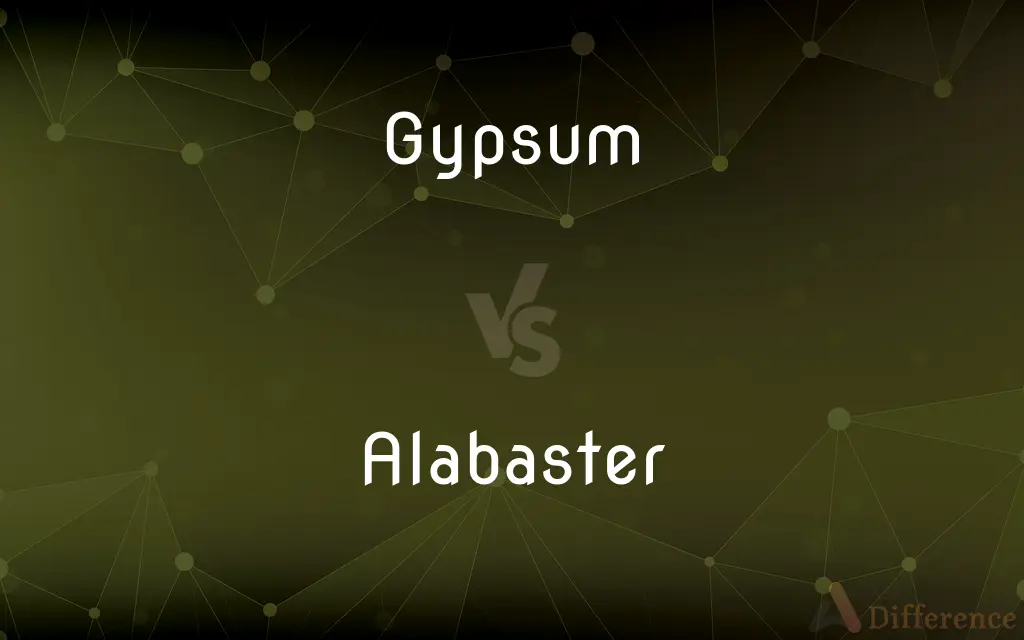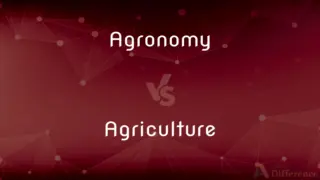Gypsum vs. Alabaster — What's the Difference?
By Tayyaba Rehman & Maham Liaqat — Updated on March 13, 2024
Gypsum is a soft sulfate mineral widely used in construction and agriculture, while alabaster is a fine-grained, translucent form of gypsum or calcite used in sculpture and decoration.

Difference Between Gypsum and Alabaster
Table of Contents
ADVERTISEMENT
Key Differences
Gypsum, composed mainly of calcium sulfate dihydrate, is known for its softness and ability to be used in various industrial applications, including drywall, plaster, and fertilizer. Whereas alabaster, specifically when formed from gypsum, is prized for its smooth, fine-grained texture and translucency, making it ideal for ornamental works and sculptures. Alabaster can also be calcite-based, distinguished by its greater hardness and use in different decorative contexts.
In terms of geological formation, gypsum is typically found in sedimentary rock layers, formed through the evaporation of sea or saline water. This process leads to large deposits that can be mined on an industrial scale. On the other hand, alabaster, while also occurring in gypsum deposits, is selected for its particular aesthetic qualities, including purity and fineness, which are less commonly found.
From a practical standpoint, gypsum's role in the construction industry as a material for drywall and plaster stems from its fire resistance and ease of use. Alabaster's use is more niche, focused on artistic and decorative pieces, where its ability to be carved into detailed shapes and its pleasant surface finish are highly valued.
Gypsum's wider availability and utility in large-scale industries contrast with alabaster's more specialized and artistic applications. The value of alabaster comes not just from its physical properties but also from the skill and creativity involved in transforming it into works of art.
The environmental conditions favoring the formation of gypsum and alabaster are specific, with gypsum requiring large evaporative basins and alabaster forming under conditions that preserve its translucency and purity. These differences highlight the distinct niches each material occupies in nature and human use.
ADVERTISEMENT
Comparison Chart
Composition
Calcium sulfate dihydrate (CaSO4·2H2O).
Gypsum-based or calcite-based (CaCO3 for calcite).
Hardness
Soft (2 on Mohs scale).
Soft when gypsum-based, harder when calcite-based.
Use
Construction, agriculture, industrial products.
Sculpture, ornamental objects, decorative pieces.
Formation
Evaporation of sea or saline water in sedimentary layers.
Selected for purity and fine grain within gypsum deposits or from calcite.
Characteristics
Fire resistant, easy to work with for industrial uses.
Fine-grained, translucent, more aesthetic value.
Compare with Definitions
Gypsum
A soil amendment in agriculture.
Farmers use gypsum to improve soil structure and reduce soil compaction.
Alabaster
A medium for religious artifacts.
Alabaster has been used for centuries to create religious icons and altarpieces.
Gypsum
A primary material in plaster.
Gypsum plaster is applied to interior walls for a smooth finish.
Alabaster
A fine-grained variant for detailed work.
Jewelers sometimes use alabaster for its soft, workable nature in delicate designs.
Gypsum
A protective agent in fireproofing.
Gypsum’s fire-resistant properties are essential in constructing safe buildings.
Alabaster
A material for sculpting fine art.
Renaissance artists carved delicate details in alabaster.
Gypsum
A casting material in art.
Artists cast sculptures in gypsum for its fine details.
Alabaster
Used in ornamental stone carving.
Intricately carved alabaster vases are valued for their translucency.
Gypsum
A mineral used in drywall manufacturing.
Gypsum boards are standard in building construction for walls and ceilings.
Alabaster
A decorative element in architecture.
Alabaster panels are incorporated into buildings for their aesthetic quality.
Gypsum
Gypsum is a soft sulfate mineral composed of calcium sulfate dihydrate, with the chemical formula CaSO4·2H2O. It is widely mined and is used as a fertilizer and as the main constituent in many forms of plaster, blackboard/sidewalk chalk, and drywall. A massive fine-grained white or lightly tinted variety of gypsum, called alabaster, has been used for sculpture by many cultures including Ancient Egypt, Mesopotamia, Ancient Rome, the Byzantine Empire, and the Nottingham alabasters of Medieval England.
Alabaster
Alabaster is a mineral or rock that is soft, often used for carving, and is processed for plaster powder. Archaeologists and the stone processing industry use the word differently from geologists.
Gypsum
A widespread colorless, white, or yellowish mineral, CaSO4·2H2O, used in the manufacture of plaster of Paris, various plaster products, and fertilizers.
Alabaster
A dense, translucent, white or tinted fine-grained gypsum.
Gypsum
A mineral consisting of hydrated calcium sulphate. When calcinated, it forms plaster of Paris.
Alabaster
A variety of hard calcite, translucent and sometimes banded.
Gypsum
A mineral consisting of the hydrous sulphate of lime (calcium). When calcined, it forms plaster of Paris. Selenite is a transparent, crystalline variety; alabaster, a fine, white, massive variety.
Alabaster
A pale yellowish pink to yellowish gray.
Gypsum
A common white or colorless mineral (hydrated calcium sulphate) used to make cements and plasters (especially plaster of Paris)
Alabaster
A fine-grained white or lightly-tinted variety of gypsum, used ornamentally.
Alabaster
(historical) A variety of calcite, translucent and sometimes banded.
Alabaster
(color) An off-white colour, like that of alabaster.
Alabaster
Made of alabaster.
The crown is stored in an alabaster box with an onyx handle and a gold lock.
Alabaster
Resembling alabaster: white, pale, translucent.
An ominous alabaster fog settled in the valley.
Alabaster
A compact variety or sulphate of lime, or gypsum, of fine texture, and usually white and translucent, but sometimes yellow, red, or gray. It is carved into vases, mantel ornaments, etc.
Alabaster
A box or vessel for holding odoriferous ointments, etc.; - so called from the stone of which it was originally made.
Alabaster
A compact fine-textured usually white gypsum used for carving
Alabaster
A hard compact kind of calcite
Alabaster
A very light white
Common Curiosities
What are the key factors in choosing gypsum for construction?
Its fire resistance, ease of use, and effectiveness as a plaster or drywall material are key factors.
How does the translucency of alabaster affect its use?
Alabaster's translucency makes it particularly attractive for sculptures and decorative objects that interact beautifully with light.
Is gypsum environmentally friendly?
Gypsum is considered environmentally friendly due to its natural abundance and the sustainability of its mining and processing.
What role does alabaster play in historical artifacts?
Alabaster has been used throughout history for art, religious artifacts, and decorative objects, valued for its beauty.
Can alabaster be made from materials other than gypsum?
Yes, alabaster can also be made from calcite, which is harder and used differently than gypsum-based alabaster.
Why is gypsum used in agriculture?
Gypsum improves soil structure, reduces compaction, and adds calcium without altering soil pH.
How are gypsum and alabaster similar?
Both can have a gypsum base, but their use and value differ significantly, with alabaster being more aesthetically focused.
What distinguishes gypsum from alabaster?
Gypsum is known for its wide range of industrial uses, whereas alabaster is specifically valued for its beauty and translucency in art and decoration.
What is the Mohs hardness of gypsum and alabaster?
Gypsum has a hardness of about 2 on the Mohs scale, and alabaster varies slightly but is similarly soft when gypsum-based.
Can alabaster be used outdoors?
Due to its softness and susceptibility to weathering, alabaster is better suited for indoor use.
Are there environmental concerns with mining gypsum?
Like all mining, gypsum extraction can impact the environment, but it is generally less intrusive and damaging compared to the mining of other minerals.
What makes alabaster a preferred material for sculptors?
Its fine grain, ease of carving, and translucency allow for detailed and visually appealing works.
How do the physical properties of gypsum and alabaster influence their respective uses?
Gypsum's softness and fire resistance make it ideal for construction and agriculture, while alabaster's fine grain and translucency make it sought after for decorative and artistic purposes.
How is calcite-based alabaster different from gypsum-based?
Calcite-based alabaster is harder and less translucent, making it suitable for different types of decorative applications.
How does the fire resistance of gypsum benefit construction?
Gypsum's fire resistance contributes to building safety, slowing the spread of fires within structures.
Share Your Discovery

Previous Comparison
Agronomy vs. Agriculture
Next Comparison
Schedule vs. RotaAuthor Spotlight
Written by
Tayyaba RehmanTayyaba Rehman is a distinguished writer, currently serving as a primary contributor to askdifference.com. As a researcher in semantics and etymology, Tayyaba's passion for the complexity of languages and their distinctions has found a perfect home on the platform. Tayyaba delves into the intricacies of language, distinguishing between commonly confused words and phrases, thereby providing clarity for readers worldwide.
Co-written by
Maham Liaqat













































